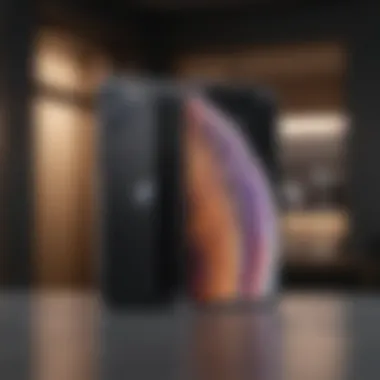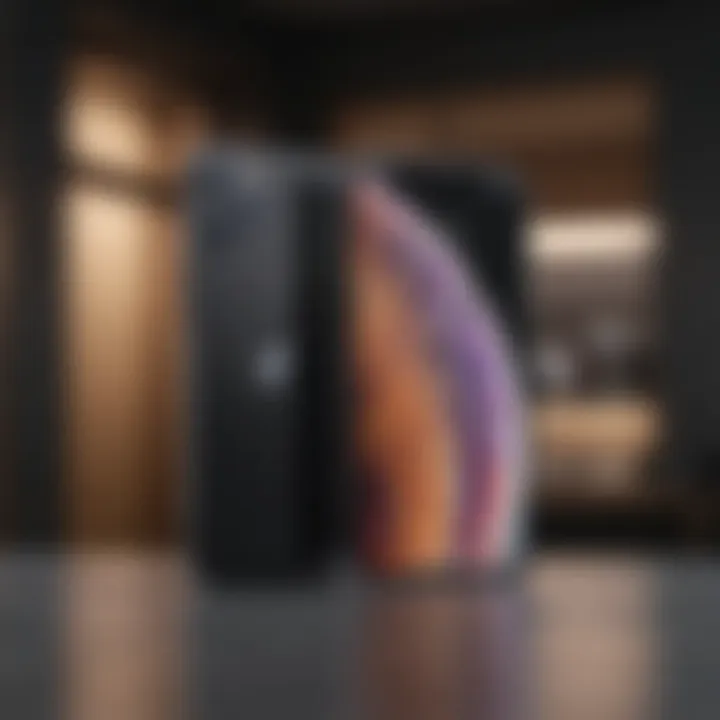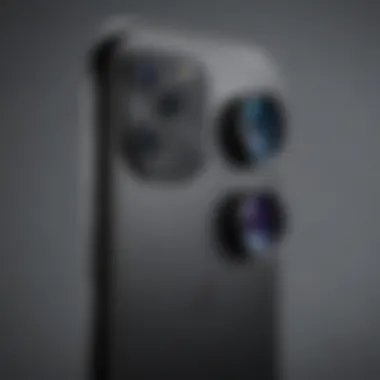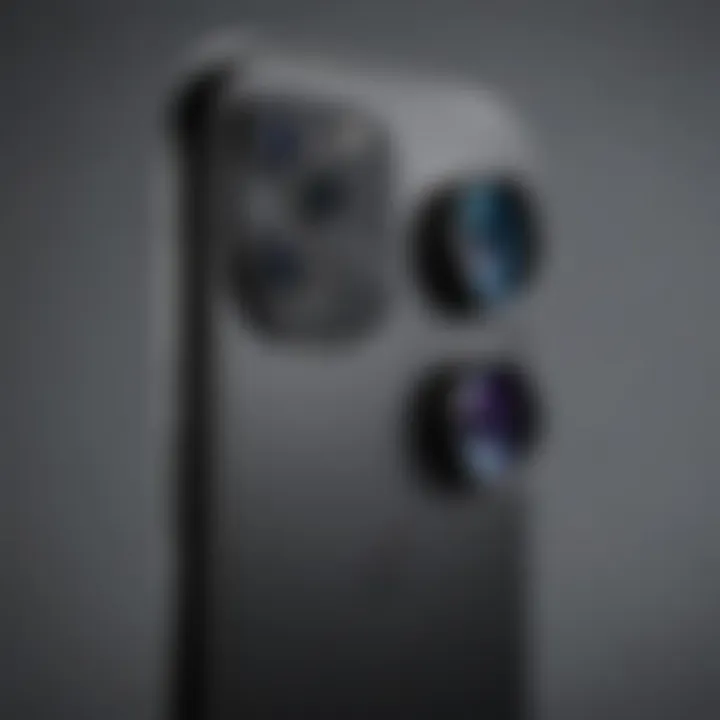Comparing iPhone 13 and iPhone X: Features and Performance


Product Overview
Intro to the Apple product being discussed
The iPhone 13, heralded as a significant leap forward, came out waving a fresh set of features compared to its predecessor, the iPhone X. While both models are emblematic of Apple's innovative design ethos, there's a world of difference beneath the surface, especially when you consider that the iPhone X made waves in its own right upon release in 2017. Fast-forward to 2021, and the iPhone 13 arrived with a new chip, better display technology, and a camera system that has a knack for capturing the essence of every moment.
Key features and specifications
When looking at the iPhone 13, it’s hard to miss some key features:
- A15 Bionic Chip: The iPhone 13 is powered by Apple’s latest chip, boasting unmatched processing power and energy efficiency.
- Improved Battery Life: Battery life receives a notable bump, allowing users to power through the day with ease.
- Camera Enhancements: The dual-camera system now features improved sensors, providing better low-light performance and advanced computational photography capabilities.
- Display: A Super Retina XDR display offers vibrant colors and deep contrasts, enhancing the visual experience.
In comparison, the iPhone X introduced features like the OLED screen and Face ID, which were cutting-edge at the time but have since found an upgrade path with the newer models.
Design and aesthetics
From a design perspective, both the iPhone 13 and iPhone X hold true to Apple's aesthetic benchmarks—minimalism mixed with functionality. The iPhone 13 features flat edges reminiscent of the iPhone 4, while the iPhone X sports a rounded design that's more in line with its predecessors. In terms of colors, the iPhone 13 expands the palette with options like starlight and midnight, which give it a modern twist. The face of the iPhone 13, however, has a smaller notch compared to the iPhone X, providing a more immersive viewing experience.
Performance and User Experience
Performance benchmarks
In practical terms, the A15 chip in the iPhone 13 leaves the A11 chip in the iPhone X in the dust. Benchmarks reveal a notable improvement in both CPU and GPU performance. Activities that require intense processing, such as gaming or video editing, feel significantly smoother and faster on the newer device.
User interface and software capabilities
Both devices run on iOS, but the iPhone 13 is designed to harness the full potential of the latest software updates. Users of the iPhone 13 benefit from features like ProMotion, which makes scrolling and animations incredibly fluid. While the iPhone X is perfectly capable of running the latest iOS, it might not support all the new features optimized for the A15 chip, resulting in a slightly less dynamic experience.
User experiences and feedback
Feedback for the iPhone 13 has overwhelmingly been positive, with users praising the camera's performance and the device's all-day battery life. On the other hand, many iPhone X owners still express satisfaction with their devices, particularly due to the sleek design and initial features that were revolutionary at the time.
"Stepping from the iPhone X to the iPhone 13 feels like upgrading from a smartphone to a super smartphone."
— Tech Enthusiast on Reddit
Comparison with Previous Models or Competitors
Advancements and improvements from previous models
The transition from the iPhone X to the iPhone 13 is dotted with improvements that underscore Apple's commitment to innovation.
- Camera: The iPhone 13 introduces improved night mode in all lenses, compared to the more basic version on the iPhone X.
- Battery: Battery longevity has improved by up to 2.5 hours on the iPhone 13 versus the iPhone X.
- Display technology: Enhanced HDR capabilities and peak brightness outshine the iPhone X's capabilities.
Competitive analysis with other similar products
When put against other flagship phones from competitors like Samsung and Google, the iPhone 13 typically stands tall thanks to its robust ecosystem, privacy focus, and more intuitive user interface. Yet, choices stemming from personal preference can play a role in selecting between Android or iOS.
Value proposition
Both the iPhone 13 and X hold their own at various price points. While the iPhone X might now be considered a budget-friendly option, the iPhone 13's offerings justify its premium pricing, especially for those valuing longevity in technology and support.
Tips and Tricks
How-to guides and tutorials for optimizing the Apple product's performance
- Maximize battery life: Turn on 'Low Power Mode' for those 'just in case' scenarios.
- Customize your home screen: Use widgets to display relevant information at a glance.
Hidden features and functionalities
Don’t overlook the focus on accessibility features in both iPhone models. Voice Control, Magnifier, and Cognitive Accessibility settings are well integrated, making the devices suitable for a broader audience.
Troubleshooting common issues
- Camera lag: Restarting the phone usually alleviates any hitches.
- Battery draining quickly: Check settings for background app refresh and location services.
Latest Updates and News
Recent developments in software updates and new features
Apple’s latest iOS updates continue to refine user experience, optimizing performance with each cycle. The introduction of SharePlay and Focus modes on the iPhone 13 has captivated many users, enhancing how they share content and manage notifications, respectively.
Industry news and rumors surrounding upcoming products
Whispers in the tech community hint at the next generation of iPhones possibly featuring foldable designs or enhanced AR capabilities. While these are mere speculations, they keep the excitement alive for Apple enthusiasts.
Events and announcements from Apple
Keep an eye on Apple’s annual events, where they typically announce their plans for the next generation of products. It’s a time when anticipation mix with unveiled surprises, providing a window into the brand's direction.
Foreword to iPhone Technology
The iPhone has evolved into more than just a smartphone; it serves as a cultural icon and a technological benchmark. Understanding the intricate tapestry of iPhone technology allows users to appreciate how each model has pushed boundaries and redefined mobile devices. This exploration of both the iPhone 13 and its predecessor, the iPhone X, reveals not only the evolution of Apple's design principles but also the core technological advancements that set these phones apart.
In examining the advancements of the iPhone over the years, we must consider historical context and the decisions made by Apple that have led to continual success. Apple's meticulous attention to detail ensures that each iteration of the iPhone doesn't just meet market standards but rather sets them. The significance of this evolution can be seen in several areas:
- User Experience: Every new iPhone comes equipped with improvements in user interface and experience.
- Performance: Specifications such as processors, RAM, and integrated software enhancements reflect Apple's commitment to superior performance.
- Camera Technology: Each model witnesses transformations in camera capabilities that cater to both casual and professional users.
These factors, among others, contribute to a conversation about how the iPhone not only keeps up with the competition but often leads it, making this exploration worth the reader’s attention.
Historical Context of iPhone Releases
The release of the first iPhone in 2007 marked the dawn of a new technological era. It wasn't just another phone; it was a revolutionary device that changed how we communicate, work, and entertain ourselves. The subsequent releases, such as the iPhone 3G in 2008 and the iPhone 4 in 2010, introduced features that, at the time, felt futuristic. Fast forward to today, where we see the iPhone 13 and its once groundbreaking predecessor, the iPhone X, in a competitive landscape of smartphones.
The iPhone X, launched in 2017, was a significant departure from its predecessors with an edge-to-edge display and the introduction of Face ID — a feature designed to enhance security while offering a fresh user experience. Meanwhile, the iPhone 13, released four years later, builds on the success of its predecessors, focusing on performance optimizations and offering sophisticated camera setups. Each new release has been accompanied by a sense of anticipation among consumers and a strategic shift within the tech industry.
"The iPhone has redefined how we communicate, turning it from a task into an experience."
Overview of iPhone and iPhone
The iPhone 13 and iPhone X are pivotal models within Apple's roster. The iPhone X was a celebration of a decade's innovation, introducing features like the Super Retina Display and the A11 Bionic chip. It set a precedent for visual aesthetics and capabilities while providing a glimpse of the future of smartphone technology.
In contrast, the iPhone 13 took that vision and expanded it. Equipped with the A15 Bionic chip, this model showcases enhanced graphics capabilities and improved energy efficiency. Additionally, camera advancements in the iPhone 13, such as the Cinematic mode for video and improved low-light performance, demonstrate the leap in technology within just a few short years.
In summary, both models represent milestones in Apple's narrative, with distinct features that cater to varying user needs and technological expectations. This contextual foundation will pave the way for deeper discussions in subsequent sections, addressing design, performance, camera technology, and more.
Design Features


Design is not merely about aesthetics; it plays a crucial role in the usability and appeal of a smartphone. For the iPhone 13 and its predecessor, the iPhone X, design features are key areas that highlight Apple’s evolution in both functionality and form. In this section, we will explore the physical dimensions, build materials, color options, and aesthetic choices that contribute to the overall user experience.
Physical Dimensions and Build Materials
The physical dimensions of a smartphone can greatly influence its ergonomics and portability. The iPhone 13 measures 146.7 x 71.5 x 7.65 mm, while the iPhone X is slightly smaller at 143.6 x 70.9 x 7.7 mm. This marginal difference makes the iPhone 13 feel a tad bulkier, but the overall design aims for a better grip.
In terms of build materials, both models boast durable glass fronts and backs, with aluminum frames. However, the iPhone 13 has been reinforced with a Ceramic Shield front cover, promising four times better drop performance than previous models. This means users can breathe a little easier when they drop their phones—something we all do from time to time.
Moreover, the iPhone 13's construction emphasizes sustainability, incorporating recycled materials which is a growing trend in modern phone design. The emphasis on tough yet elegant materials maintains Apple's reputation for both luxury and durability. Hence, the iPhone 13 aligns with current consumer demands for products that are both aesthetically pleasing and made with environmental considerations in mind.
Color Options and Aesthetics
When it comes to colors, both the iPhone 13 and X offer distinctive choices that cater to different tastes. The iPhone X launched with a polished silver and space gray that gave it a sleek, sophisticated look. In contrast, the iPhone 13 introduces a vibrant array that includes colors like pink, blue, midnight, starlight, and PRODUCT(RED). This broader palette caters to a more diverse audience, inviting users to express their individuality.
The aesthetics of the iPhone 13 have not just expanded in color but also in design details. With a more refined camera design placing the lenses diagonally, a balanced look flows throughout the device, giving it a modern vibe. Meanwhile, the iPhone X has a more traditional vertical camera setup. These subtle changes can feel like a reflection of technological advancement, making the iPhone 13 seem more cutting-edge.
In summary, the design features of both models demonstrate Apple's commitment to not just innovation in technology but also in how these devices are visually and physically experienced by their users. As you would expect from a brand innovating in both technology and aesthetics, the shift from iPhone X to iPhone 13 illustrates a balance between timeless design and modern trends, which appeals to both pragmatists and enthusiasts alike.
Display Technology
When it comes to smartphones, one of the most vital aspects that users notice first is the display. Why? Because it acts as the primary interface through which we interact with our devices. The display technology used influences everything from clarity and color accuracy to usability under various lighting conditions. In the case of the iPhone 13 and its predecessor, the iPhone X, understanding the differences in display technology is crucial for tech enthusiasts and Apple aficionados alike.
Screen Size and Resolution Comparison
The iPhone 13 presents a screen size of 6.1 inches, while the iPhone X has a slightly smaller display at 5.8 inches. This difference might seem minimal, but it allows for a more immersive experience with the iPhone 13. Both models come equipped with OLED technology, which is notable for its vibrant colors and deep blacks. However, it's important to point out that the increase in screen real estate in the iPhone 13 facilitates improved multitasking, presenting a tangible benefit for users who frequently juggle multiple applications.
Resolution plays a significant role, too. Both devices boast a resolution of 2436 x 1125 pixels but the iPhone 13 slightly edges out the iPhone X in pixel density due to its overall size, providing sharper text and images. Many users appreciate how crisp details appear when looking at everything from photos to detailed documents.
In terms of aspect ratio, both maintain a similar 19.5:9 ratio, which aligns closely with that of the human eye. This commonality helps in offering comfortable viewing experiences across various media formats, with no noticeable distortion in either device. However, if you are a fan of large visuals—be it games, videos, or maps—the iPhone 13 naturally provides a more expansive and pleasing view.
"The display serves not just as a window, but as a doorway to your digital life."
Brightness and Color Accuracy
Brightness and color accuracy are other significant factors influencing display technology. The iPhone X shines brightly at approximately 625 nits, providing adequate visibility even under direct sunlight. However, the iPhone 13 ups the ante with brightness levels reaching 800 nits in typical use and even soaring to 1200 nits for HDR content. This means that in various conditions, especially when outside on a sunny day, the iPhone 13 users gain a tangible advantage in usability.
Color accuracy is also paramount for individuals who rely on their smartphones for photography and design work. Both phones utilize True Tone technology, which adjusts the display based on ambient lighting conditions to ensure colors appear consistent and true-to-life. However, reviews and tests of the iPhone 13 reveal that it provides slightly broader color support along with improved saturation, enhancing not just the vibrancy of images but also the overall aesthetic experience on the device.
In sum, when comparing display technology between the iPhone X and iPhone 13, the advancements in brightness and color accuracy contribute to more enjoyable photo-taking, media consumption, and everyday scrolling experiences. This holds particular significance for users who prioritize visual fidelity, thereby shaping their interaction with the device in a meaningful way.
Performance Metrics
Performance metrics are critical for understanding how devices stack up against each other, especially when it comes to smartphones like the iPhone 13 and iPhone X. These metrics provide not only a glimpse into the processing power and efficiency of a device but also direct implications for user experience, game performance, multitasking, and battery management. Simply put, performance isn't just a set of numbers; it directly affects how smooth and responsive the phone feels in real-world usage.
In this section, we will deep dive into two pivotal elements of performance metrics: Processor capabilities and Benchmark comparisons. Understanding these aspects will be essential for any user looking to gauge the true strengths and weaknesses of these models.
Processor Capabilities
The brain of a smartphone lies within its processor, and this is where the iPhone 13 really starts to pull away from its predecessor, the iPhone X. The iPhone 13 houses the A15 Bionic chip, renowned for its speed and efficiency. This chip boasts a six-core CPU which balances performance and power, integrating powerful graphics processing alongside sophisticated machine learning features. In contrast, the iPhone X features the older A11 Bionic chip. While not shabby when released, it doesn't hold a candle to the advancements we find today.
The benefits of a more powerful processor aren't just on paper. An A15 powered iPhone delivers faster animations, quicker app launches, and improved handling of resource-intensive tasks like gaming and video editing. It allows users to maintain a smoother experience even when multitasking with heavy applications.
Moreover, the thermal efficiency of the A15 means less heat produced during operation, which can extend the life of the internal components. It's said that performance metrics can sometimes be a dry subject, but when you realize how they translate into your everyday experiences, they become incredibly relevant.
Benchmark Comparisons
Benchmark scores are often viewed as the gold standard when comparing smartphones. They serve as a barometer of general performance. Various testing platforms, like Geekbench and Antutu, provide illuminating insights into how the iPhone 13 and iPhone X hold up.
- Single-Core Performance:
- Multi-Core Performance:
- iPhone 13: Typically scores above 1600.
- iPhone X: Usually caps around 900.
- iPhone 13: Often exceeds 4600.
- iPhone X: Roughly around 4500 in ideal conditions.
What these scores indicate is quite telling. The iPhone 13 not only comes out ahead, but pushes the envelope in both single and multi-threaded environments—meaning it's more adept at handling both simple tasks and heavy lifting with ease.
At the end of the day, it’s important to remember that while benchmarks provide numerical comparisons, the real-world difference in use, particularly for those who rely on their devices for advanced tasks, can be marked.
Camera Technology
The camera has become a cornerstone feature in smartphones over the years, and the comparison between the iPhone 13 and iPhone X highlights this trend effectively. In today's world, where social media dominates communication, the ability to capture high-quality images has never been more significant. This section focuses on the mechanical prowess and innovative features that define the camera setups of these two models, providing a deeper understanding of how Apple has catered to the evolving needs of its users.
Modern smartphone photography goes beyond the conventional snap-and-share. It's about storytelling framed within pixels. With that said, let’s delve into how both devices approach this art form, including specifications and real-world performance.
Camera Specifications Overview
At first glance, the specifications beneath the sleek surfaces of the iPhone 13 and iPhone X reveal a technological divide. The iPhone X was equipped with a dual 12-megapixel system, while the iPhone 13 stepped up its game significantly with a sophisticated setup: also a dual 12-megapixel but enhanced through computational photography capabilities.
Here's a more detailed breakdown:
- iPhone X:
- iPhone 13:
- Rear Camera: 12 MP wide and 12 MP telephoto, f/1.8 and f/2.4 apertures
- Front Camera: 7 MP, f/2.2 aperture, capable of 1080p video recording
- Rear Camera: 12 MP ultra-wide and 12 MP wide, f/1.6 and f/2.4 apertures
- Front Camera: 12 MP, f/2.2 aperture, features Night mode and HDR
The differences may seem subtle, but they translate into distinct capabilities, especially in low-light situations. The iPhone 13's larger sensor and improved optics assure greater light intake.
Photography Features and Performance
When it comes to photography, the numbers tell a part of the story, but the true magic lies within how these features play out in real-world use. The Night mode introduced with iPhone 11 made its mark as a notable advancement. The iPhone 13 builds on this legacy with further refinements, allowing for clearer, more vibrant night shots.
Additional standout features include:
- Cinematic Mode: Exclusive to iPhone 13, this allows for videos with shallow depth-of-field effects, simulating the look of professional film.
- Photographic Styles: Customizable presets that adjust tone and color without affecting the image quality, it’s a fresh take on personal style.
- Smart HDR 4: Enhanced to recognize faces in scenes better and to balance highlights and shadows accurately.
User feedback has highlighted significant improvements in color accuracy and contrast, especially in outdoor settings. Many reviews indicate how the additional computational efforts result in photographs that not only preserve details but also appear more true to life.
"The camera takes amazing photos that always grab the attention, whether you’re snapping a quick picture or creating artistic shots in low light."
Battery Life Analysis
Battery life stands as a pivotal factor when evaluating smartphones, especially in today's fast-paced world. Users often prioritize devices that can last through their daily routines without constantly searching for a charger. In the context of the iPhone 13 and its predecessor, the iPhone X, understanding battery capacity, longevity, and charging technology provides an insightful lens through which to examine how Apple has evolved its flagship product. Battery life not only impacts usability but also influences user satisfaction, highlighting its importance in product selection.
Battery Capacity and Longevity


When it comes to battery capacity, the iPhone 13 clearly shines. Apple's iPhone X, released in 2017, housed a battery capacity of 2716 mAh. In contrast, the iPhone 13 boasts a significantly larger 3240 mAh battery. This increase in size might not seem like much at first glance, but it translates to a far more robust performance in real-world scenarios.
With advancements made in technology, users of the iPhone 13 can enjoy approximately 2.5 hours more battery life compared to the iPhone X on a full charge. This enhancement is especially beneficial for those who frequently engage in power-hungry tasks such as gaming or streaming videos. The longevity of the battery also reflects Apple’s dedication to providing a seamless experience without the nuisance of low battery alerts.
The following details outline key aspects of the battery capacities:
- iPhone X: 2716 mAh
- iPhone 13: 3240 mAh
- Expectation of Usage Time: The iPhone 13's battery can handle typical usage scenarios such as browsing, calling, and media consumption much more efficiently, making it favorable for both casual users and those with heavier demands.
Charging Technology Comparison
Charging technology has also seen significant advancements between the two models, emphasizing user convenience and efficiency. The iPhone X supported wired charging at 5W, which, while adequate for its time, can feel sluggish compared to modern standards.
In stark contrast, the iPhone 13 supports up to 20W fast charging—implying that users can charge their devices from 0 to about 50% in just around 30 minutes. This leap represents a clear understanding of users' needs; in our busy lives, who wants to spend half their day tethered to a charger?
Moreover, both models offer wireless charging capabilities, but the iPhone 13 has improved efficiency and compatibility with MagSafe, allowing for an even more convenient charging experience.
In summary, here’s a quick comparison of charging features:
- iPhone X:
- iPhone 13:
- Wired Charging: 5W
- Wireless Charging: Compatible with Qi
- Wired Charging: Up to 20W
- Wireless Charging: Supports MagSafe and Qi-Compatible methods
Users are finding that the advancements in charging technology not only save time but also elevate the overall experience with their devices. In a world governed by connectivity and immediacy, these improvements are not just beneficial; they're nearly essential.
"While the iPhone X set a standard for its time, the iPhone 13 has raised the bar in battery longevity and charging efficiency, ultimately catering to a more demanding user base."
Engagement with devices has become more than just casual use—it's a full-time interaction. And as such, both battery life and charging capabilities play a crucial role in defining how users interact with their iPhones.
User Experience and Interface
In the realm of modern smartphones, the User Experience (UX) and Interface (UI) play a pivotal role. In discussing the iPhone 13 and its predecessor, the iPhone X, it’s vital to examine how these elements contribute to the whole iPhone experience. A well-designed UX/UI not only makes navigation intuitive but also fosters a deeper connection between the user and the device. Apple's commitment to creating an easily usable, visually appealing interface has always been one of its defining characteristics, adding real value.
Operating System Features
The operating system is the backbone that defines how an iPhone operates. The iPhone 13 runs iOS 15, which brings an array of features designed to enhance usability and streamline tasks.
Some key elements of iOS 15 that stand out include:
- Improved Notifications: Users can now focus more easily, with enhanced notification summaries that keep distractions at bay while ensuring important alerts are seen.
- Focus Mode: This feature allows users to customize notifications and app access throughout different times of day. Whether for work, sleep, or relaxation, users can tailor their devices to suit their current needs.
- FaceTime Enhancements: With the introduction of spatial audio and grid view in FaceTime, the experience feels more connected, almost like being in the same room.
- Widgets and Customization: iOS has embraced user customization, allowing widgets on the home screen that can be resized and repositioned to create a personal touch.
On the other hand, iPhone X users operate on iOS 14. While still robust and user-friendly, it lacks some of the newer enhancements. The original features like the App Library and compact design for calls and Siri function well, but one can see that the evolution in iOS is driven by user feedback and emerging tech trends.
User Feedback and Reviews
User feedback and reviews give precious insights into the real-world applications of these smartphones. Both the iPhone 13 and iPhone X have enjoyed strong positive feedback.
- iPhone X is often praised for its pioneering edge-to-edge display and introduction of Face ID, which was a leap from the Touch ID. Users comment on the premium feel and aesthetic appeal, making it a timeless choice even as new models flow in.
- iPhone 13 has received glowing notes for its battery life, especially when compared against the iPhone X. Users frequently mention how seamless the transition between apps is, alongside comments about picture quality that make photography a joy.
However, it's not all roses. Some users have voiced concerns about the weight of the iPhone 13 and its size compared to older models, while others miss some earlier features like dedicated headphone jacks.
"Ultimately, while specs and features are important, it is the subjective experience—how it feels in daily use—that dictates satisfaction."
Both the iPhone 13 and X showcase Apple’s focus on UX and interface design, although the iPhone 13 reflects several iterations of feedback that have led to further refinement. As these devices evolve, so does the conversation around how they fit into users' lives.
Connectivity and Network Performance
In a world where everything is interconnected, connectivity and network performance are at the forefront of smartphone capabilities. For both iPhone 13 and its predecessor, iPhone X, how these devices handle connectivity can determine user experience significantly. The ability to stay connected—whether through cellular networks, Wi-Fi, or Bluetooth—affects how well users can communicate, access content, and utilize apps. In this section, we’ll dissect the nuances of connectivity features and what they mean for your everyday smartphone experience.
5G Capabilities and Compatibility
With the launch of the iPhone 13, Apple stepped into the future by integrating 5G technology, a shift that exemplifies its commitment to staying ahead in the tech race. The iPhone 13 supports both sub-6 GHz and mmWave 5G, providing users access to faster download and upload speeds. This enhancement is particularly notable when streaming HD content, gaming, or video conferencing—scenarios that demand quick response times and substantial bandwidth.
In contrast, the iPhone X lacks 5G support, relying solely on the 4G LTE standard at best. While it performed admirably in its time, the absence of 5G in the X highlights the technological leap made with the iPhone 13. Users upgrading from the X may notice a noticeable increase in network responsiveness. Consider these points regarding 5G capabilities:
- Speed: Theoretically, 5G can deliver speeds up to 10 Gbps—far beyond what the typical user experiences with 4G.
- Latency: Reduced latency means actions like online gaming or video calls happen with less lag, which can improve overall user satisfaction.
- Compatibility: As 5G rolls out worldwide, having a device like the iPhone 13 ensures compatibility with the latest network technologies, future-proofing your investment.
"Embracing 5G on the iPhone 13 represents not just a speed increase, but a whole new landscape for mobile applications and services that can now thrive on faster networks."
Wi-Fi and Bluetooth Performance
Alongside cellular connectivity, the performance of Wi-Fi and Bluetooth is crucial in everyday smartphone use. The iPhone 13 features Wi-Fi 6 capabilities, allowing for better efficiency, even in crowded networks. This is an impressive upgrade over the iPhone X, which only supports older Wi-Fi standards. Wi-Fi 6's benefits include:
- Higher capacity: Better management of multiple devices on the same network, a boon for homes full of smart devices.
- Improved performance: Faster data transfer rates and lower latency.
- Extended range: Connections are stronger even at longer distances from the access point.
For Bluetooth, the iPhone 13 utilizes Bluetooth 5.0, which enhances range and speed. This means not only can your device connect to wireless headphones or speakers from a farther distance, but it also enables connections with lower energy consumption—a crucial factor for battery life.
While the iPhone X offers older Bluetooth standards that suffice for basic functions—like connecting to headphones or car systems—the improvements in the iPhone 13 reflect a broader shift toward a seamless, more integrated tech ecosystem in which users expect every aspect of connectivity to be instantaneous and reliable.
In summary, connectivity and network performance are critical elements in the discussion of the iPhone 13 versus the iPhone X. Whether you're utilizing 5G, Wi-Fi 6, or advanced Bluetooth features, there's little doubt that the newer model is designed to meet the demands of today's digital landscape, making it an important consideration for potential buyers and tech enthusiasts alike.
Software and Services
The realm of technology has always been intertwined with the software that powers devices. In the case of the iPhone 13 and its predecessor, the iPhone X, software doesn't merely add functionality; it shapes the entire user experience. This section delves into how software and services play a pivotal role in the overall appeal and usability of these models.
iOS Features and Updates
iOS serves as the backbone for Apple's smartphones, and with each new version, significant enhancements come to the table. Starting with iOS 15 that initially rolled out for the iPhone 13, users found a suite of features designed to streamline interactions and improve accessibility. From Focus mode that helps eliminate distractions to the revamped FaceTime that allows spatial audio for a more immersive video chatting experience, Apple has made strides in user-centric design.
In contrast, the iPhone X was released with iOS 11, establishing a strong foundation with features like Animoji and the original iteration of Face ID.
Benefits of iOS updates include:
- Enhanced Security: Regular updates aid in patching vulnerabilities, keeping user data protected.
- Improved Performance: With every software upgrade, Apple optimizes apps and functionalities to run smoother, benefitting even older hardware.
- New Features: Each iOS iteration introduces functionalities that make daily tasks easier and improve the way users interact with their devices.
Apple has maintained an ethos of seamless integration between hardware and software, making the user experience both intuitive and engaging. It is this steadfast commitment to evolution that entices consumers to upgrade their devices regularly.
Services Integration (iCloud, Apple Music, etc.)
When considering the value proposition of the iPhone 13 compared to the iPhone X, it’s crucial not to overlook the broad array of services that Apple offers. iCloud, for example, facilitates the synchronization of files, photos, and documents across devices, ensuring that no matter where you are, your important data is just a tap away.
Moreover, services like Apple Music elevate the device's functionality. This subscription-based service offers millions of songs and playlists, allowing easy access to music both online and offline. With personalized recommendations tailored to users' listening habits, it doesn’t just serve as a listening platform; it becomes a way to discover new music aligned with personal tastes.
The impact of features tied to these services includes:


- Cloud Storage Options: iCloud’s ability to back up entire device settings saves users from future headaches during upgrades or new devices.
- Cross-Device Accessibility: Users can manage their content from any Apple device smoothly, ensuring versatility in usage.
- Enhanced Multimedia Experience: From streamlined sharing options in Apple Music to simplified photo management in iCloud, these services are designed to enhance enjoyment and functionality.
“The connectedness of Apple’s ecosystem is what keeps users coming back for more, allowing seamless transitions not just between devices but between services.”
The amalgamation of software features and integrated services forms a comprehensive ecosystem that continues to set Apple apart in the tech industry. Each iteration and update, whether tied to the iPhone 13 or iPhone X, emphasizes the company's profound understanding of its users' needs.
Environmental Impact and Sustainability
In today’s technology-driven age, environmental impact and sustainability have transcended mere buzzwords; they are a crucial aspect of product development and consumer choice. For tech giants like Apple, the environmental footprint of their devices—like the iPhone 13 and iPhone X—reflects not just company values but also increasingly attentive consumer expectations. As people grow more conscious of their ecological footprint, evaluating the sustainability measures of products becomes a key element in purchase decisions. This section sheds light on how Apple addresses these pressing concerns through various initiatives and practices.
Material Sourcing and Recycling Programs
Apple has long been on a journey to minimize its ecological footprint, starting at the very beginning: material sourcing. The company places a significant emphasis on using recycled materials in its devices. For instance, the aluminum in the iPhone 13 comes from recycled sources, reducing the need for newly mined materials and, thus, helping to decrease carbon emissions associated with raw material extraction. Apple has made public commitments to using 100% recycled rare earth elements in future products, showcasing their dedication to responsible sourcing.
The recycling programs Apple has implemented also play a pivotal role in its sustainability strategy. The Apple Trade In program allows customers to return their old devices in exchange for credit towards future purchases. This initiative not only encourages recycling but also promotes the continued usability of older devices, extending their lifecycle.
"By employing innovative recycling technologies, Apple hopes to close the loop, turning old devices into new ones, thus reducing waste and conserving resources.”
Furthermore, Apple's Daisy robot, designed to disassemble old iPhones, has made significant strides in reclaiming valuable materials from devices that would otherwise end up in landfills. Through such initiatives, Apple demonstrates an active effort to mitigate product waste and promote a circular economy.
Energy Efficiency Ratings
Another critical aspect of sustainability is energy efficiency. The iPhone 13, like its predecessor the iPhone X, comes with features designed to optimize energy use. Not only do these devices boast impressive performance metrics, but they also aim for lower energy consumption, which indirectly reduces greenhouse gas emissions.
Apple has consistently received high energy efficiency ratings for its products, especially in performance modes aimed at conserving battery life. The A15 Bionic chip, for example, offers remarkable processing power while being energy efficient, allowing the device to operate effectively without draining the battery unnecessarily. This ensures users can enjoy cutting-edge technology without compromising on responsible energy use.
Price and Value Proposition
When discussing consumer technology like smartphones, price and value proposition are two sides of the same coin. They capture not just the financial investment a user makes when purchasing a device, but the perceived worth that accompanies it. This analysis serves as a compass during the journey of choosing between models, particularly between the iPhone 13 and its predecessor, the iPhone X. With evolving features and innovations, understanding the price dynamics and the inherent value in these devices can greatly influence a decision-maker’s choice.
Market Pricing Trends
In the world of smartphones, prices fluctuate like the tides. When the iPhone X launched in 2017, it was a game changer, both in terms of technology and price point. Positioned at a premium, it set the benchmark at around $999. Fast forward to late 2020, when the iPhone 13 hit the market, starting at a slightly less steep price of $799. The difference is noteworthy, not just because of inflation, but due to the technology market's relentless march forward.
As you delve deeper into market pricing trends, several key elements come to light:
- Inflation Adjustments: Prices often rise due to general inflation. Comparing the 2017 price of the iPhone X to its eventual resale or discounted prices brings clarity.
- Innovation Leads to Value: The iPhone 13 packed features like improved photo capabilities, faster processors, and vibrant displays all at a reduced launch price relative to the iPhone X’s introduction.
- Seasonal Sales and Discounts: Black Friday, Cyber Monday, and back-to-school sales can sway prices dramatically. Often, retailers will compete fiercely for consumer attention during these periods, offering steep discounts that could lower the iPhone’s prices significantly.
- Emerging Competitors: The rise of other smartphone brands also pressures Apple to reconsider its pricing strategies. Devices from companies like Samsung and Google aimed at similar markets have undoubtedly played a role in shaping the pricing landscape.
Lifecycle and Resale Value
Smartphones don’t just sit in your pocket or on your desk - they have a lifecycle. This lifecycle is critical when we discuss the idea of resale value. The iPhone X, being several years old now, might not hold its initial price as robustly as when it first came out.
- Depreciation: Just as with cars, smartphones lose value over time. Generally, you can expect a high-end device like the iPhone X to depreciate by 50% after two years.
- Apple's Brand Loyalty: iPhones tend to retain a better resale value compared to other brands. Loyal customers are often willing to pay a premium for something that comes with the Apple logo, even if it’s older tech.
- Condition Matters: The resale value significantly depends on the condition of the device. A well-maintained iPhone 13 will fetch a higher resale price than a battered iPhone X.
- Timing the Market: Selling at the right moment can tip the scales. Questions about an upcoming release can flood the market and prompt consumers to sell older models quickly.
Comparative Analysis: iPhone vs iPhone
Understanding the Comparative Analysis of the iPhone 13 and iPhone X is crucial, especially for those who wish to grasp how Apple's flagship product has evolved over the years. This analysis not only highlights the advancements in technology but also provides insights into user preferences, market trends, and design philosophies that shape these devices.
The differences and similarities in design, features, and performance give a clear picture of what Apple has retained and what it has reimagined. In this article, we will delve into two main subtopics that will clarify this comparative landscape.
Similarities and Differences
When comparing the iPhone 13 and its predecessor, the iPhone X, it's vital to note both striking similarities and key differences.
Similarities:
- Design Principles: Both devices uphold Apple's sleek, minimalist design ethos. The glass and aluminum build provides a premium feel, with tasteful finishes that aim to impress.
- Face Recognition Technology: Each model incorporates Face ID for unlocking, though the tech itself has improved in terms of speed and accuracy.
- iOS Ecosystem: Users of both phones enjoy similar access to apps and Apple services, creating a familiar interface and overall user experience.
Differences:
- Display Technology: iPhone 13 offers a brighter Super Retina XDR display, boasting better outdoor visibility and color accuracy compared to the OLED panel of the iPhone X.
- Camera System: The iPhone 13 features improved dual-camera technology with an enhanced Night Mode and Cinematic Mode, making it superior for photography and videography.
- Battery Life: A noticeable leap in battery performance is evident with the iPhone 13, which can last up to 2.5 hours longer than the iPhone X.
- Processor: The A15 Bionic chip in the iPhone 13 provides substantial performance enhancements over the A11 Bionic chip used in the iPhone X, translating into faster app launches, smoother multitasking and better gaming performance.
"In every iteration, Apple not only aims to meet consumer demands but also sets the standard in innovation and design."
Which Model Suits Different Users?
The choice between the iPhone 13 and the iPhone X hinges on user needs and budget considerations.
- Tech Enthusiasts and Professionals: Users who appreciate cutting-edge technology and camera capabilities will likely prefer the iPhone 13. Its advanced features cater to those who use their devices for work, particularly in content creation or graphic design.
- Budget-Minded Consumers: Individuals looking for a reliable smartphone with proven capabilities might feel that the iPhone X serves them well. It still offers a solid performance for everyday tasks without breaking the bank.
- Casual Users: Those who mainly use their phones for calls, texts, and casual browsing might find that the iPhone X meets their needs just fine. However, with the advancements in the iPhone 13, it may also be worth considering if they plan to use the device long-term.
- Photography Lovers: For users who prioritize capturing high-quality images and leveraging enhanced camera features, the iPhone 13 is the clear winner due to its superior photographic software and hardware.
As both devices cater to diverse user bases, the decision will ultimately depend on personal requirements, budget, and how users intend to engage with their smartphones.
Future of iPhone Technology
The future of iPhone technology carries substantial weight in understanding not only current technological trends, but also the trajectory Apple will take in the coming years. As innovation cycles quicken, the anticipation surrounding what Apple will showcase next can’t be overstated. The focus on optimizing hardware, enhancing user experiences, and tapping into more sustainable practices is evident. Moreover, understanding these future directions helps consumers and developers align their expectations and strategies effectively, increasing value around developments made by Apple.
Insights into Upcoming Releases
With every new release, Apple tends to set the bar higher in the field of mobile technology. Although the exact details often remain closely guarded secrets until the official announcements, one can look at developers' tendencies and industry leaks to gauge potential features of future iPhone models. It’s insightful to consider how the company has carefully pivoted in technology adoption.
For instance:
- Processor Enhancements: Apple is continually refining its silicon chips. Future models will likely sport more powerful processors with improved energy efficiency, enhancing both speed and performance for applications.
- Display Technology: Speculations suggest that we might see advancements in display technology, possibly moving towards a higher refresh rate or even integrating features like under-display Face ID.
- Camera Innovations: As smartphone photography becomes ever more sophisticated, upcoming models are expected to push boundaries with better low-light performance and advanced computational photography capabilities.
With these insights, professionals working in tech should keep an eye on Apple’s annual events to unveil such technologies. The advancements not only impact consumer choices, but they also ripple across the tech ecosystem, prompting competitors to rise to the occasion.
Potential Innovations in iPhone Design and Functionality
Design and functionality are at the core of what gives the iPhone its identity in an overcrowded smartphone market. Apple’s approach tends to marry aesthetics with usability, and upcoming models will likely continue this tradition. Keeping in perspective the ever-changing consumer preferences and technological advancements, potential innovations could include:
- Material Usage: Apple has been exploring ways to integrate more sustainable materials into their design. Future iPhones might employ new composites or recycled materials without compromising durability and aesthetics.
- Biometric Features: Innovations in biometric security could also be on the horizon. Enhanced Face ID and perhaps even advanced fingerprint scanning technologies integrated into the display may evolve.
- Improved Ergonomics: Feedback from users frequently drives design changes. Future iPhones may embrace new form factors, delving into foldable or modular designs that cater better to the multi-tasking needs of users.
- Enhanced AR Capabilities: As augmented reality becomes more mainstream, one can expect innovations that enhance AR experiences—improving interaction methods and visual outputs.
All these advancements reflect not just a continuation of Apple’s commitment to innovation, but also its response to shifting consumer demands, which is critical to maintaining its leading position in the market.
Finale
Drawing to a close, it's crucial to highlight the extensive journey that both the iPhone 13 and its predecessor, the iPhone X, have taken the smartphone market on. This article provides a rich tapestry of information, exploring the myriad of ways these two devices serve not only as technology marvels but also as cultural artifacts that reflect shifting consumer expectations and technological capabilities.
Recap of Key Findings
The analysis of the iPhone 13 in contrast with the iPhone X reveals several significant developments in key areas:
- Design: While both models boast stunning aesthetics, the iPhone 13 introduces subtle enhancements, such as narrower notches, and a flat-edge design reminiscent of the iPhone 4, contrasting the rounded edges of the iPhone X.
- Performance: The leap in processing power from the A11 Bionic chip in the iPhone X to the A15 Bionic in the iPhone 13 showcases a tangible shift in speed and efficiency.
- Camera capabilities: The evolution of camera technology is evident, with the iPhone 13 featuring improved low-light performance and novel photographic styles that elevate user experience.
- Battery life: With a bigger battery and Apple’s efficiency prowess, the iPhone 13 significantly outlasts its predecessor in day-to-day use.
- User experience: iOS updates bring a continuously evolving interface, ensuring users stay engaged and satisfied with their devices.
This recap succinctly brings together the technical and design advancements that have taken place, emphasizing how Apple constantly pushes the envelope in the smartphone arena.
Final Thoughts on iPhone Evolution
Reflecting on the progression from the iPhone X to the iPhone 13 reveals not just a timeline of upgrades, but also an intentional journey driven by Apple’s commitment to innovation. The transition between these two devices underscores deeper trends in technology, such as:
- The growth of user-centric design, putting aesthetics and functionality at the forefront.
- The emphasis on sustainability and environmental impact, which is increasingly influential among today's consumer base.
- The continuous integration of software and services that enhance user engagement and deepen brand loyalty.
As we gaze into the future, it's evident that the evolution of the iPhone represents more than just hardware advancements. It's a narrative of technological evolution, consumer demand, and an unfolding story that is likely to define the mobile experience for years to come. No doubts linger that Apple will continue to adapt and refine its offerings, echoing the needs of tech-savvy users and shaping the broader landscape of mobile technology.



